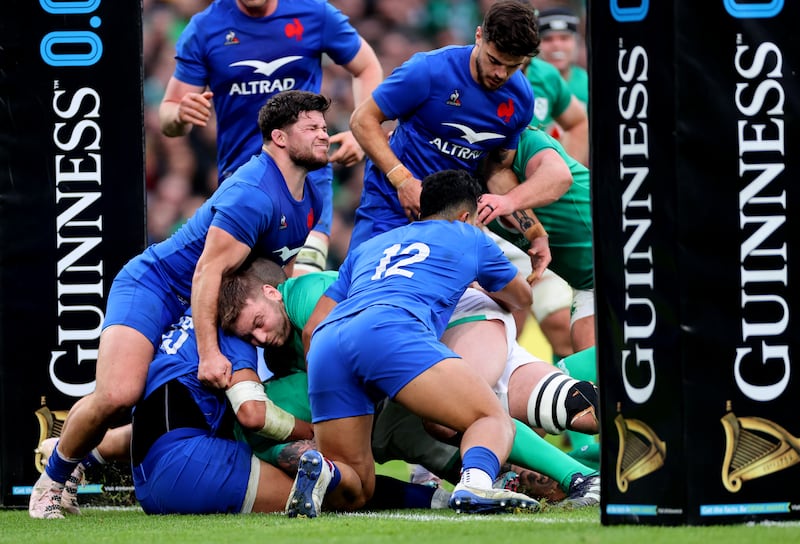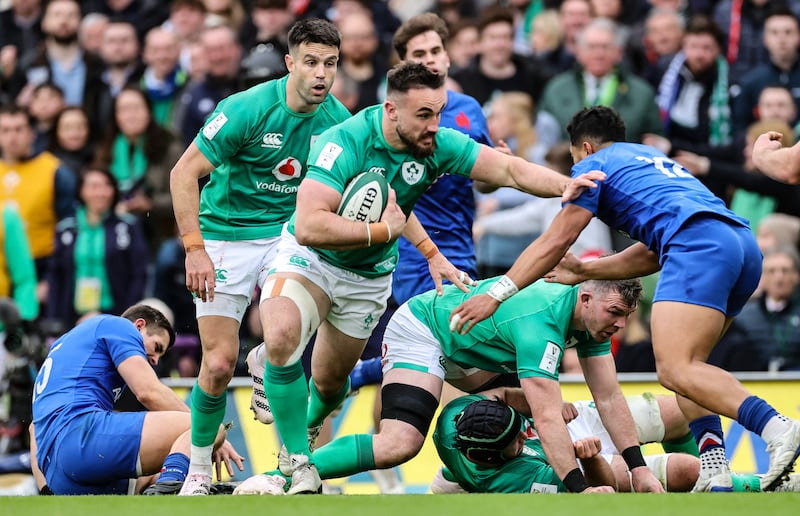Coaches do love a work-on, to use their vernacular, especially after a victory as it nips in the bud any trace signs of complacency that might otherwise take root.
Andy Farrell touched on the odd blemish here and there in an on-pitch interview in the immediate aftermath of Ireland’s 32-19 Six Nations win over reigning Grand Slam champions France at the Aviva Stadium, more a note to self than any criticism of what was, fundamentally, a brilliant Irish victory in many respects.
[ Sign up for our new weekly rugby newsletter from Gerry Thornley Opens in new window ]
While, as he always does, pushing the plaudits firmly towards his players, Ireland’s head coach referred to the fact that by being a tad more clinical, the team might have converted more try-scoring opportunities, a reference to the handful of occasions when they were either held up over the French line or got very narrow in attacking orientation.
In some of those instances Ireland could have played to the space rather than try to use brute force to penetrate the massed ranks in blue around the fringes of the breakdown. Hindsight provides an unerring clarity but even in the maelstrom of a match, Farrell will review with his players on what picture they saw at the time and why they took certain decisions.
READ MORE
It’s an essential process that underpins the continual development of a team, challenging players to make better choices. The first of those moments begins with an Ireland lineout maul on six minutes, which the French prise apart. Peter O’Mahony rescued the ball, Caelan Doris gave his team a positive gainline and 90 seconds later, the home side had a ruck a couple of metres from the French line.

Ireland had four attackers – Johnny Sexton, Stuart McCloskey, Josh van der Flier and Mack Hansen – on the short side to two and a half French defenders, so called because Yoram Moefana is very tight to the ruck.
There is little animation from the Irish players, their alignment and body language betray the fact they aren’t seeking the ball. It’s a ‘no-no’. Look at the All Black teams in their pomp, everyone is an option in those circumstances, therefore forcing the defending team to stretch to cover all options, creating more space.
Instead, Conor Murray hits Andrew Porter but his pass is slightly high and at the inside shoulder, forcing the prop to check for an instant. And even though he drove over the line, Cyril Baille, assisted by Antoine Dupont and Gregory Alldritt, managed to hold Porter, so to speak. The consolation was that Ireland scored the game’s first try, through Hugo Keenan, less than a minute later.
[ Six Nations tickets: Pressing need for Irish fans to raise their gameOpens in new window ]
On 25 minutes Murray picks and goes for the line from a close-in ruck and would have scored if not illegally thwarted by Romain Ntamack and Thibaud Flament, both of whom are offside in effecting a double tackle. It was the right decision by the scrumhalf and should have been a penalty try and a card but again Ireland grabbed a try immediately after through Porter.
Farrell will reflect on several more occasions that should have enjoyed a more lucrative outcome. When Murray’s pass that bounces in front of James Ryan – he does superbly to pull his hands away in time – and is collected by Tadhg Beirne momentum was stifled as the home side went hunting the French line again; when Hansen is brilliantly thwarted by Dupont; and finally when the Irish wing’s basketball pass goes into touch.

In the first instance, the players are static, the second is down to Dupont’s sheer strength and the third, the wrong option to go back to the short side initially where Ireland were outnumbered. In the 37th minute, Ireland are again within touching distance of the French line.
Murray, sharp and alive, is denied principally by Baille’s headlock tackle; 60 seconds later Ireland have a five-on-three in the backs but once again take on France’s massed fringe defence. Murray then does brilliantly to rescue a ball that shoots out from a ruck and make it over the line only to be denied by Charles Ollivon’s tackle.
In the second half there are two further occasions when Ireland come within a whisker of scoring, the first is down to a questionable decision or two and stationary ball carriers that are both easily identifiable for the defence and are taking the ball from a standing start. The lack of deception or nuance allowed the French players to get off the line aggressively and double up in the tackle.
When Jack Conan snaffled a loose ball at a French lineout, Tom O’Toole made inroads, Ryan coming on to the ball at pace, got over the gainline but Rónan Kelleher was thwarted as he drove over the line. This is by no means a comprehensive list, but it did illustrate a couple of recurring issues that Ireland had with their attacking shape.
It cannot and should not detract from a brilliant victory. Every performance can be improved. Farrell, and his coaching team have shown in taking Ireland through a succession of landmark achievements, that they can guide a receptive squad of players to ever greater heights with no fear of vertigo.
It’s the appetite to learn and the aptitude to improve and refine that is shortening the road ahead to where they want to go.
















